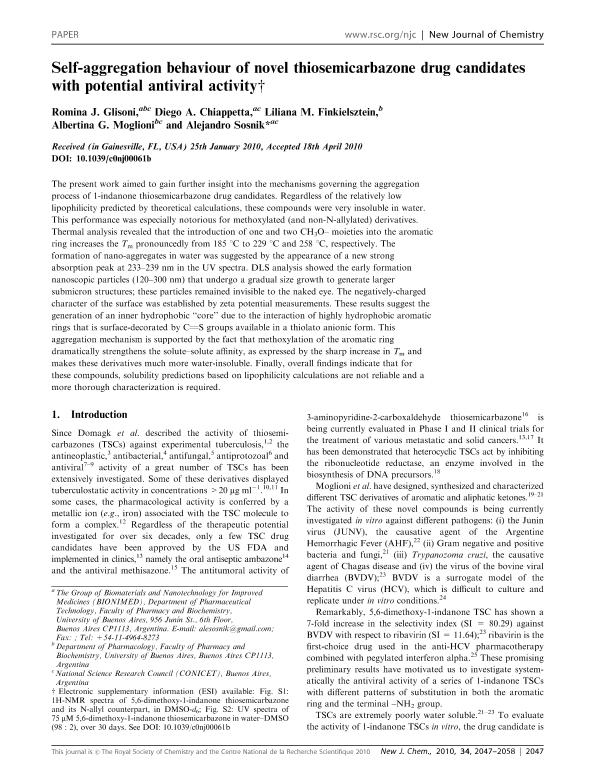Mostrar el registro sencillo del ítem
dc.contributor.author
Glisoni, Romina Julieta

dc.contributor.author
Chiappetta, Diego Andrés

dc.contributor.author
Finkielsztein, Liliana Mónica

dc.contributor.author
Moglioni, Albertina Gladys

dc.contributor.author
Sosnik, Alejandro Dario

dc.date.available
2020-09-02T13:41:06Z
dc.date.issued
2010-06
dc.identifier.citation
Glisoni, Romina Julieta; Chiappetta, Diego Andrés; Finkielsztein, Liliana Mónica; Moglioni, Albertina Gladys; Sosnik, Alejandro Dario; Self-aggregation behaviour of novel thiosemicarbazone drug candidates with potential antiviral activity; Royal Society of Chemistry; New Journal of Chemistry; 34; 9; 6-2010; 2047-2058
dc.identifier.issn
1144-0546
dc.identifier.uri
http://hdl.handle.net/11336/112987
dc.description.abstract
The present work aimed to gain further insight into the mechanisms governing the aggregation process of 1-indanone thiosemicarbazone drug candidates. Regardless of the relatively low lipophilicity predicted by theoretical calculations, these compounds were very insoluble in water. This performance was especially notorious for methoxylated (and non-N-allylated) derivatives. Thermal analysis revealed that the introduction of one and two CH3O- moieties into the aromatic ring increases the Tm pronouncedly from 185 °C to 229°C and 258 °C, respectively. The formation of nano-aggregates in water was suggested by the appearance of a new strong absorption peak at 233-239 nm in the UV spectra. DLS analysis showed the early formation nanoscopic particles (120-300 nm) that undergo a gradual size growth to generate larger submicron structures; these particles remained invisible to the naked eye. The negatively-charged character of the surface was established by zeta potential measurements. These results suggest the generation of an inner hydrophobic "core" due to the interaction of highly hydrophobic aromatic rings that is surface-decorated by CS groups available in a thiolato anionic form. This aggregation mechanism is supported by the fact that methoxylation of the aromatic ring dramatically strengthens the solute-solute affinity, as expressed by the sharp increase in Tm and makes these derivatives much more water-insoluble. Finally, overall findings indicate that for these compounds, solubility predictions based on lipophilicity calculations are not reliable and a more thorough characterization is required.
dc.format
application/pdf
dc.language.iso
eng
dc.publisher
Royal Society of Chemistry

dc.rights
info:eu-repo/semantics/openAccess
dc.rights.uri
https://creativecommons.org/licenses/by-nc-sa/2.5/ar/
dc.subject
SELF-AGGREGATION
dc.subject
THIOSEMICARBAZONE
dc.subject
ANTIVIRAL ACTIVITY
dc.subject.classification
Otras Nanotecnología

dc.subject.classification
Nanotecnología

dc.subject.classification
INGENIERÍAS Y TECNOLOGÍAS

dc.title
Self-aggregation behaviour of novel thiosemicarbazone drug candidates with potential antiviral activity
dc.type
info:eu-repo/semantics/article
dc.type
info:ar-repo/semantics/artículo
dc.type
info:eu-repo/semantics/publishedVersion
dc.date.updated
2020-08-19T19:39:56Z
dc.journal.volume
34
dc.journal.number
9
dc.journal.pagination
2047-2058
dc.journal.pais
Reino Unido

dc.journal.ciudad
Cambridge
dc.description.fil
Fil: Glisoni, Romina Julieta. Universidad de Buenos Aires. Facultad de Farmacia y Bioquímica. Departamento de Tecnología Farmacéutica; Argentina. Consejo Nacional de Investigaciones Científicas y Técnicas. Oficina de Coordinación Administrativa Houssay; Argentina
dc.description.fil
Fil: Chiappetta, Diego Andrés. Universidad de Buenos Aires. Facultad de Farmacia y Bioquímica. Departamento de Tecnología Farmacéutica; Argentina. Consejo Nacional de Investigaciones Científicas y Técnicas. Oficina de Coordinación Administrativa Houssay; Argentina
dc.description.fil
Fil: Finkielsztein, Liliana Mónica. Universidad de Buenos Aires. Facultad de Farmacia y Bioquímica. Departamento de Farmacología; Argentina
dc.description.fil
Fil: Moglioni, Albertina Gladys. Consejo Nacional de Investigaciones Científicas y Técnicas. Oficina de Coordinación Administrativa Houssay; Argentina. Universidad de Buenos Aires. Facultad de Farmacia y Bioquímica. Departamento de Farmacología; Argentina
dc.description.fil
Fil: Sosnik, Alejandro Dario. Consejo Nacional de Investigaciones Científicas y Técnicas. Oficina de Coordinación Administrativa Houssay; Argentina. Universidad de Buenos Aires. Facultad de Farmacia y Bioquímica. Departamento de Tecnología Farmacéutica; Argentina
dc.journal.title
New Journal of Chemistry

dc.relation.alternativeid
info:eu-repo/semantics/altIdentifier/url/https://pubs.rsc.org/en/Content/ArticleLanding/2010/NJ/C0NJ00061B
dc.relation.alternativeid
info:eu-repo/semantics/altIdentifier/doi/http://dx.doi.org/10.1039/C0NJ00061B
Archivos asociados
